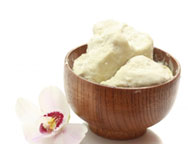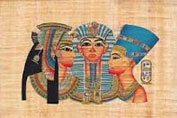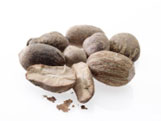The Benefits and facts about Shea Butter

Shea butter is a creamy, semisolid fat made from the seeds of shea trees, which are native to Africa. It contains many vitamins (such as vitamins E and A) and skin-healing compounds. It is used as a skin moisturizer and as an oil in foods like chocolate. Shea nuts are nuts from the shea tree.
Should shea nuts or shea nut products be a concern to consumers with tree nut or peanut allergy? Certainly, shea nuts are tree nuts. However, shea nuts as such are not typically consumed in the North American diet but are part of the African diet where Shea trees are native.
The Shea tree (Butyrospermum parkii), is small (usually 40 - 45 ft high) and has a spreading canopy. The tree very much looks like the American Oak. It has a very thick bark which is highly fissured and fire resistant. The tree is found abundantly across West Africa where it grows naturally in the woods.
Each tree can produce an average 15 to 20 kilograms of fruit each year, with peak production of up to 45 kilograms. Each shea fruit is about the size of a large plum, with a thin nutritious pulp surrounding the large nut from which shea butter is made.
Shea trees are medium-sized trees, growing to be about 10-15 meters (33-49 feet) tall, with a densely branched, round growing habit. The thick, spongy bark is fireproof, and protects the trees from the many wildfires that often destroy other nearby vegetation. Trees take 10 to 15 years to start bearing fruit, with peak production starting at 20 years, and can produce nuts for up to 200 years. The trees bloom with creamy white blossoms for a month or two, and then shea fruits grow and ripen for four to six months. The green fruits turn a rich brown when fully ripe.
Shea butter has soothing, moisturizing, and protecting effects. Due to the presence of a sizeable quantity of unsaponifiable fats, its content in vitamins and other active elements, Shea butter adds other more precise activities to these general properties. It displays a protecting role against UV rays because of its content in cinnamic acid and can thus be incorporated in solar products. The natural latex contained in Shea butter would moreover prevent certain sun allergies. Shea butter also helps cell regeneration and capillary circulation. This favors the healing of small wounds, skin cracks and crevices, and skin ulcers. In the cosmetic field, this property is an asset against skin aging. It has restructuring effects on the epidermis, also on dry and fragile hair. Dry skin, dermatitis, dermatoses, eczema, sun burn, and burns are all helped by natural Shea butter. It has an anti-elastics characteristic which makes it a good active ingredient against stretch marks.
Shea butter can also be used to treat rheumatism and aching muscles, and to ease colds because it decongests nasal mucous tissues. It is very well tolerated by the skin for it does not normally trigger any allergic reaction and can even be used on very sensitive skin areas such as mucous tissues and around the eyes.
Anti-inflammatory and healing properties: Shea butter has been proven to have extensive anti-inflammatory properties. Redness and swelling on your face may be calmed by applying shea butter products.
Emollient properties: The rich tree-nut oils in shea butter can soak into your skin, creating a smooth and soft barrier that seals in moisture. This moisturizing effect can last several hours.
Anti-aging properties: Shea butter has also been reported to have anti-aging properties. If true, the exact mechanism is not well-known and may be related to promoting collagen production or decreasing the breakdown of collagen that is already present.
Side effects and risks
Shea butter is an incredibly low-risk topical ingredient. Allergic reactions to shea butter are rare. Even people who are allergic to tree nuts, the family that shea nuts belong to, have a minimal risk of reaction to shea butter on their face. Researchers believe this is because shea nuts contain little of the tree-nut proteins that trigger allergies. But that does not mean there are not any risks to using it. Given the consistency of shea butter, it is likely to be comedogenic.
Just Jameen uses raw shea butter in all the creams from our Frappe Lotion to the Body Butter with coconut oil and Beeswax to our Creamy Shea creamy. As we stated in our grape seed oil blog, we use grapeseed oil in all our products as well. If your skin is very dry our Body Butter or Creamy Shea should be your cream of choice. If you do not have very dry skin Frappe will be your best product. Try one of the creams and let us know what you think by emailing deborah@justjameen.com.
FUN FACTS
01
It is Great for Cooking

In its purest form, shea butter is edible and can be used as cooking oil. Shea fruit is also edible, and sometimes chocolate companies replace cocoa butter with shea butter in the production process. Many companies mix their shea butter with other products but still say “shea butter” on the label, so read your ingredients to be informed!
02
It is Fat

Shea Butter is the ivory-colored fat that is extracted by crushing and boiling the nuts grown by the shea tree, which grows in the savannahs of west and central Africa. Shea nut trees can be found in 19 different African countries.
03
It Was Cleopatra’s Fav

Cleopatra used shea butter, and there is mention of caravans of clay jars filled with shea butter for her use. It is also said that shea was beloved by the Queen of Sheba and Nefertiti.
04
It Has Several Names

The word “shea” is said to be derived from the tree’s name in Mali’s Bambara language. What we call “shea” is also known as mangifolia, karite nut, galam butter and bambuk butter, amongst other names.
05
It is a Multipurpose Product

Shea butter is a truly multipurpose product. It is said to help reduce or heal wrinkles, stretch marks, acne scars, poison ivy, insect bites, psoriasis, and age spots. It is believed to heal skin allergies and outbreaks, and in Nigeria, it is rubbed around the nostrils to alleviate congestion and sinus issues. Whipped shea butter helps for scalp issues, offers a measure of sun protection, and helps to seal in moisture for natural hair. Non-food grade or cosmetics-grade shea can be used for making candles, and for fuel for lamps.